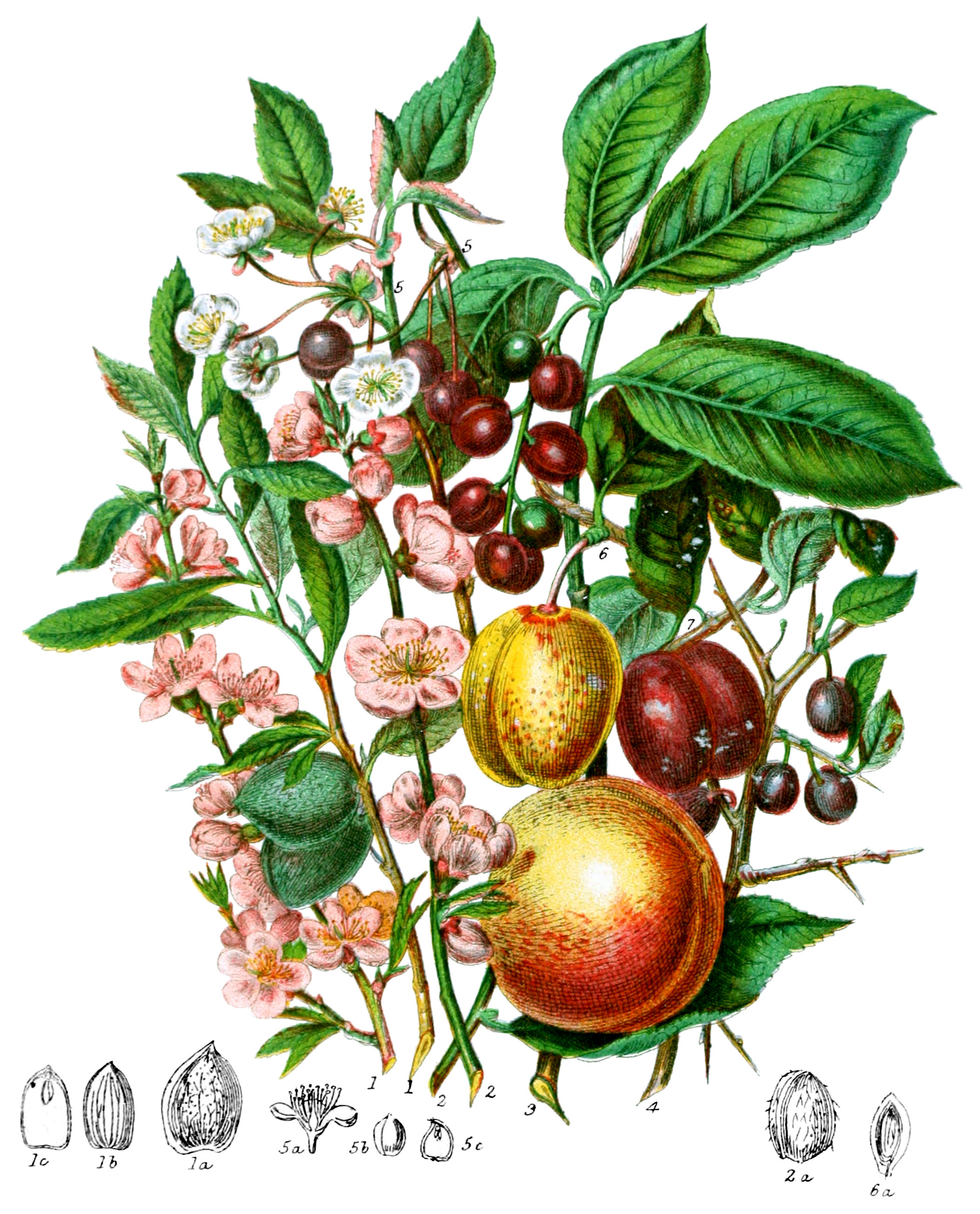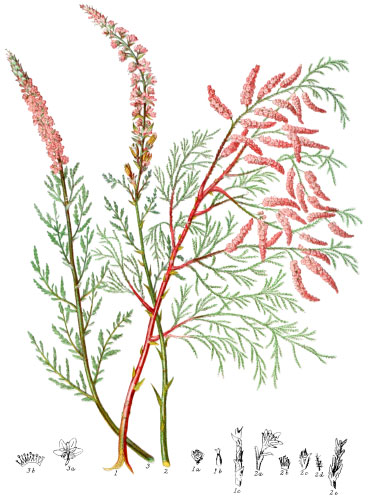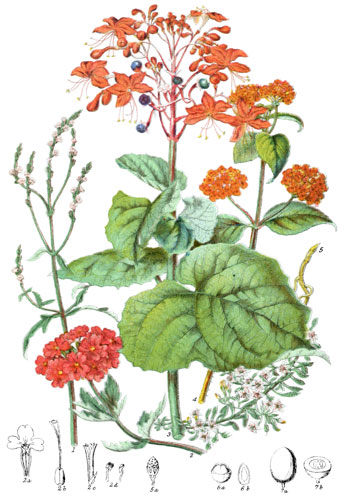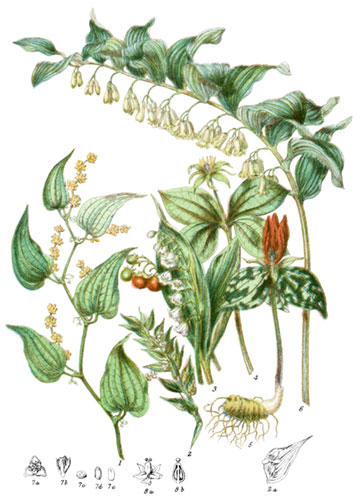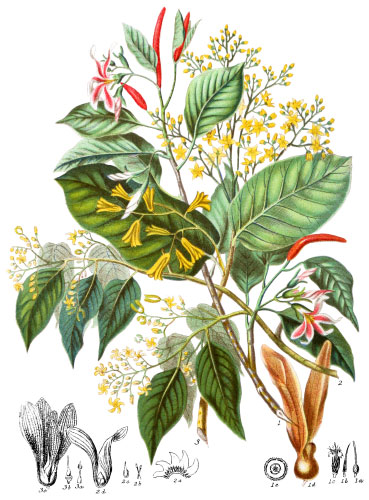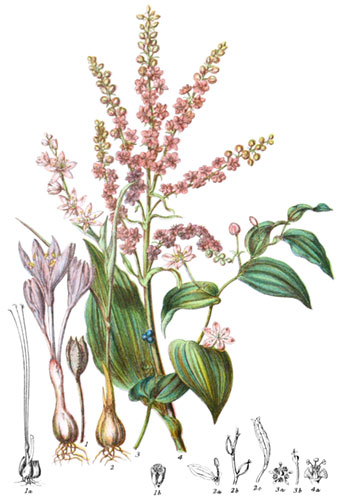Key characteristics
Trees and shrubs; the leaves are simple, alternate, usually having small glands towards the base; the stipules are simple, mostly glandular. The flowers are either single or in umbels; the calyx is five-toothed, lined with a disk, deciduous, the fifth lobe next the stem or axis, as in the Rose tribe: the petals are five, placed on the calyx. The stamens are about twenty, arising from the throat of the calyx, curved inwards in the bud; the anthers are two-celled; the style is terminal, with a furrow on one side, terminating in a kidney-shaped stigma. In Chrysobalanus and its allies the styles proceeds from the base of the ovary. The fruit is a drupe, the pulpy substance sometimes separating spontaneously from the shell; the seed is generally solitary, suspended in the shell, contains no albumen.
This tribe is distinguished from Rose and Apple tribes by the fruit being a simple drupe, by the secretion of prussic acid, and by the bark exuding gum; the latter property shows affinity with the Mimosa amongst the Leguminous plants.
Select plants in this order
Not all plants listed are illustrated and not all plants illustrated are listed.
- Amygdalus was so named by the Greeks, the fruit being cultivated and esteemed in ancient times throughout the Levant.
- During the last three centuries, the Almond-tree (1) has been constantly planted in English shrubberies, it is abundant in all the southern countries of Europe. The best sweet almonds are produced in the neighborhood of Malaga, the kernels contain a fixed oil, which renders them pleasant to the taste, as well as useful for some medicinal purposes.
- A. amara, the bitter almond, has less oil, and possesses narcotic and poisonous qualities, owing to a considerable portion of prussic acid; the bitter principle is not in the oil, but in the substance left after the oil has been expressed.
- A. microphylla is found on the hot dry plains of Mexico; a species named A. cochinchinensis is said to be a native of woods in China.
- Persica vulgaris (2) was brought to Europe from Persia, and about 1562 was first cultivated in England; in Lombardy, Peach-trees are planted in the vineyeards, and serve as supports to the vines, which hang in festoons between them; the large juicy fruit is one of the most delicious both in flavour and substance, although, even when ripe, it contains a less proportion of sugar then most of the stone fruits.
- P. lævis, the Nectarine, ranks next to, and belongs to the same countries as the Peach, and is chiefly distinguished by having a smooth instead of downy skin; both flourish remarkably in a small island in the Persian Gulf, together with Almonds and several other fruits not belonging to this tribe.
- Cerasus Laurocerasus (3) is amongst the most beautiful of evergreen shrubs; it was introduced from Constantinople, and has now become very hardy in our climate: all parts contain poison; the oil obtained is extremely virulent, and is said to be still more so in Brazil than in Temperate regions; the vapour is sufficient to destroy insect life.
- C. avium (5) is supposed to be the origin of our cultivated Cherries, several varities now abound here, and on the Continent, and are of much value; a large-fruited kind in the Black Forest, and in the Vosges, yields the German Kirschenwasser. The leaves of the Cherry-tree are folded simply flat when young; those of the Plum are rolled inwards.
- C. Padus, the British Bird-cherry, bears flowers in long spikes; the fruit is nauseous to man, though eaten by birds.
- C. Puddum, of the Himalayas, bears pink flowers, the fruit is small but delicious, and is employed for making cherry-brandy, the wood is used in Nepal for walking-sticks by the Fakeers.
- C. undulata and C. cornuta grow on mountains in India;
- the leaves of C. capricida are poisonous to goats.
- Prunus spinosa (4) is a rigid shrub with branches ending in a spine, the astringent fruit is not eatable until wrinkled by frost, then only cooked with sugar; the juice is used to adulterate Port wine, and the leaves for the same purpose with Tea.
- P. domestica affords several varieties of cultivated Plum, some of which are of excellent quality and extensively used; when dried, they are usually called by the French name of Prunes; an immense number are prepared annually in France and Portugal; in some parts of Saxony the highways are bordered by Plum-trees, supplying Sweden with the favourite winter fruit.
- P. armeniaca, the Apricot, has an extensive range over the East, especially on the high lands; it exists also between the Niger and the Atlas mountains in Africa, and abounds on the mountains of Caucasus; along the banks of the Sutledge and other rivers of Bokhara it flourishes, with many other stone fruits; on the Hindoo-koosh the traveller may pass amny miles through orchards of Apricot-trees, where the fruit attains the greatest perfection. The chemical changes which operate in the ripening process of fruits is singularly known in apricots; in a green state, scarcely a trace of sugar is found, but when ripe, there is a considerable quantity, while the malic acid is diminished one-third.
- Chrysobalanus differs from the usual type of this Order in having irregular petals and stamens; a style from the base of the ovary, and a stone with five angles.
- The fruit of C. Icaco, the Cocoa-plum (8)* is eaten in the West Indies; that of C. luteus in Sierra Leone, where the Gray-plum Paranarium excelsum also affords food to the natives.
Locations
This tribe belongs to the cold and Temperate regions of the northern hemisphere, with very few exceptions; Chrysobalanus and its allies are natives of the tropics of Africa and America.
Legend
- Amygdalus communis, Sweet Almond. Barbary.
- Shell.
- Kernel.
- Section.
- Persica vulgaris, Common Peach. Persia.
- Stone.
- Cerasus Laurocerasus, Common Laurel. Levant.
- Prunus spinosa, Sloe, or Blacktohrn. England.
- Cerasus avium, Wild Cherry. England.
- Unnamed.*
- Stone.*
- Section.*
- Prunus domestica, Golden Drop, cultivated.
- Prunus domestica, Orleans Plum, cultivated.
- Stone of Chrysobalanus Icaco.‡
- *5a was named “Stone,” 5b was labeled as “section,” and 5c was not named in the original description.
- †6a was not named in the original description.
- ‡8 was not labeled in original illustration.
Explore more
Posters
Decorate your walls with colorful detailed posters based on Elizabeth Twining’s beautiful two-volume set from 1868.
Puzzles
Challenge yourself or someone else to assemble a puzzle of all 160 botanical illustrations.
